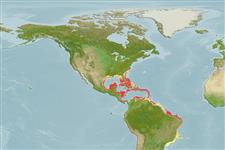>
Gobiiformes (Gobies) >
Gobiidae (Gobies) > Gobiinae
Etymology: Priolepis: Greek, prio = to saw + Greek,lepis = scale (Ref. 45335).
Environment: milieu / climate zone / depth range / distribution range
Écologie
marin récifal; non migrateur; profondeur 1 - 130 m (Ref. 26938). Tropical
Western Atlantic: southern Florida, USA and Bahamas to northern South America.
Taille / Poids / Âge
Maturity: Lm ? range ? - ? cm
Max length : 4.6 cm TL mâle / non sexé; (Ref. 6937)
Épines dorsales (Total) : 6; Rayons mous dorsaux (Total) : 10; Épines anales: 1; Rayons mous anaux: 9. Orange-red with poorly defined, dusky vertical bars (Ref. 26938). Usual color dull orange with narrow light bluish gray bars (8 on body including one at caudal base); median fins with rows of small orange spots (Ref. 13442).
Found on shallow bottoms of coral reefs with clear water (Ref. 13628). Usually found on undersides of ledges and roofs of caves (Ref. 26938). Feeds on minute crustaceans (Ref. 9710).
Life cycle and mating behavior
Maturities | Reproduction | Spawnings | Egg(s) | Fecundities | Larves
Benthic spawner. Also Ref. 103751.
Robins, C.R., R.M. Bailey, C.E. Bond, J.R. Brooker, E.A. Lachner, R.N. Lea and W.B. Scott, 1991. Common and scientific names of fishes from the United States and Canada. Am. Fish. Soc. Spec. Publ. (20):183 p. (Ref. 3814)
Statut dans la liste rouge de l'IUCN (Ref. 130435)
Menace pour l'homme
Harmless
Utilisations par l'homme
Pêcheries: commercial; Aquarium: Commercial
Outils
Articles particuliers
Télécharger en XML
Sources Internet
Estimates based on models
Preferred temperature (Ref.
123201): 23.8 - 28, mean 26.7 °C (based on 332 cells).
Phylogenetic diversity index (Ref.
82804): PD
50 = 0.5000 [Uniqueness, from 0.5 = low to 2.0 = high].
Bayesian length-weight: a=0.01023 (0.00477 - 0.02194), b=3.02 (2.84 - 3.20), in cm total length, based on LWR estimates for this (Sub)family-body shape (Ref.
93245).
Niveau trophique (Ref.
69278): 3.5 ±0.50 se; based on food items.
Résilience (Ref.
120179): Haut, temps minimum de doublement de population inférieur à 15 mois (Preliminary K or Fecundity.).
Fishing Vulnerability (Ref.
59153): Low vulnerability (10 of 100).
Nutrients (Ref.
124155): Calcium = 226 [103, 561] mg/100g; Iron = 1.27 [0.60, 2.50] mg/100g; Protein = 18.3 [16.2, 20.0] %; Omega3 = 0.199 [0.076, 0.444] g/100g; Selenium = 35.9 [14.2, 83.1] μg/100g; VitaminA = 126 [33, 454] μg/100g; Zinc = 2.83 [1.74, 4.41] mg/100g (wet weight);
